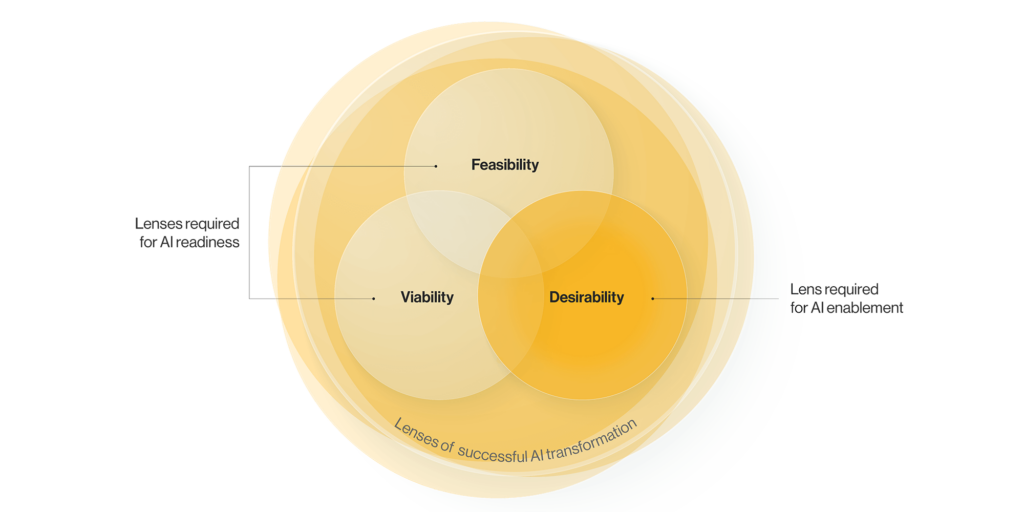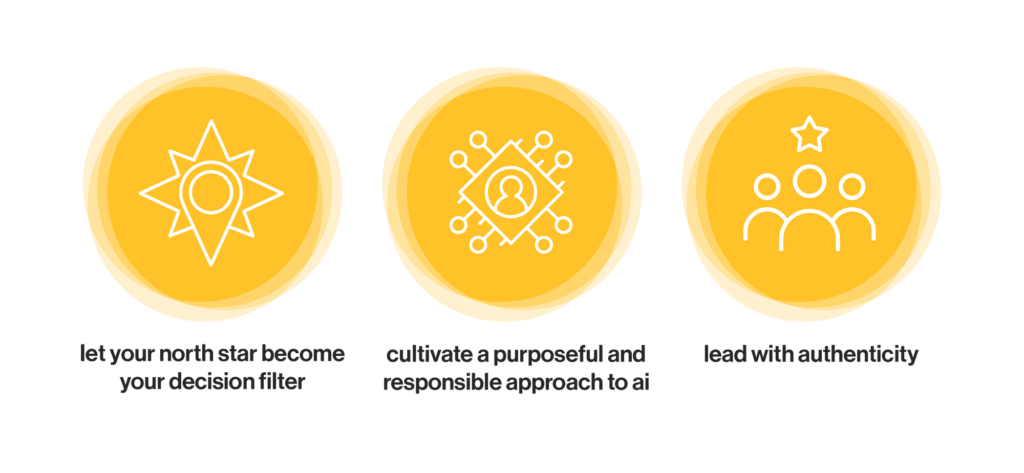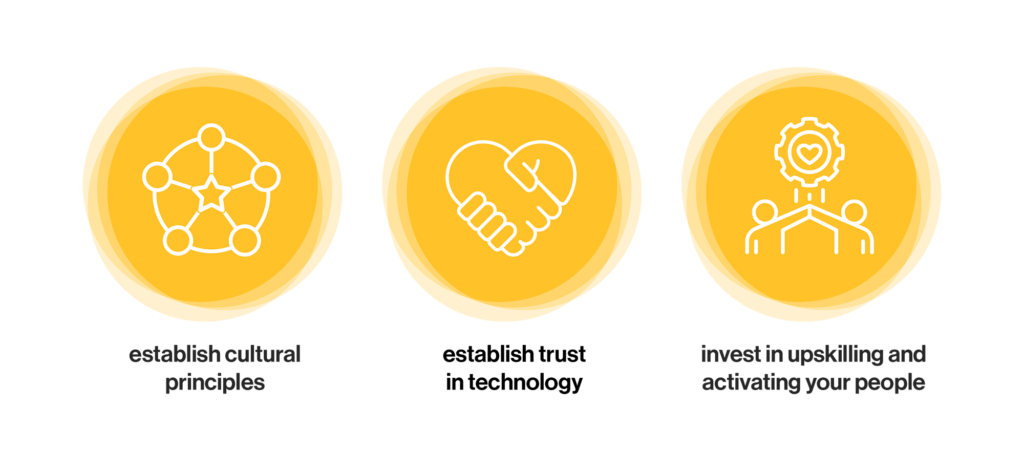SYNOPSIS
Artificial Intelligence (AI) appears to have limitless potential for transforming employee productivity and corporate success. With technical innovation progressing swiftly and frequently already programmed into place, businesses may have reached AI-readiness in terms of the technology. Being AI-ready, however, is insufficient: 70% of AI-related digital transformations fail because adopting the technology ignores the human component and fails to see that change necessitates human AI empowered (1). That is why leaders and organizations who want to implement AI services successfully need take a step back and thoroughly adjust their roll-out strategy. Using Purpose as a North Star to create cultural resilience can help to support the critical transition from an organization that is technically AI-ready to one that is AI-empowered
70% of AI implementation fails because it oversees a crucial factor
In the last 6 months, the pace of AI development has accelerated exponentially to heights previously unimaginable, with generative AI including Chat GPT, Codex, and DALL-E 2 now able to write rap songs, screenplays, essays and generate text to images within a matter of seconds. Almost 85% of CEOs believe artificial intelligence will help their firms gain or maintain a competitive advantage (2).
But recent breakthroughs in AI also raise concerns about how this will transform and disrupt organizational culture at its core. How will AI change the way we work? What skills will be needed? Will there be any work left for us humans at all? The good news first. Humans aren’t going anywhere. But while AI is transforming and improving at rapid speed, taking your people on this journey is vital for organizations to capitalize on the vast benefits that AI has to offer.
The failure to address the human need In the AI transformation of businesses is the subject of recent BCG research: While extensive amounts of financial means are directed towards setting up the right architecture and hiring the best talent, around 80% of engineered AI is never fully deployed, 70% of which fails because they overlook the human dimension- desirability (3). This includes factors such as culture, behaviors, and organizational processes.
As with anything that develops at the speed of this current technology: humans have trouble understanding the implications of how technologies will transform their lives. Deploying transformative technologies needs to take into account the impacts on all the stakeholders – how current jobs will be augmented and ultimately reimagined, with whole new jobs being created. If AI deployments don’t take care of the human dimension, they will lead to failure – resistance to change needs to be overcome with thoughtful human centered design and humane holistic design (4).
Stephen Mills, Chief AI Ethics Officer at BCG recently commented that “AI is fundamentally about a cultural transformation, and this requires support from everyone within an organization, from the top down” (5). Well informed stakeholders must therefore be at the heart of any corporate AI transformation: Their empowerment will be the deciding factor between transformation failure and success.
Bridging the technology-human divide is crucial for AI implementation success
The sweet spot of successful AI implementation lies at the intersection of three lenses that have steered similarly large transformations in the global industry, such as digital transformations, for years (6):
- Feasibility: AI must drive business outcomes; all the technologies required (hardware and software, but also the data itself) must augment, replace and/or reimagine current processes.
- Viability: AI must have the potential to drive value – create, deliver and capture value; it must have a path to drive bottom line operating profit that exceeds investment.
- Desirability: AI must consider all the implications to the human dimension – augmenting, reimagining and creating net new jobs and ways of working; to do this it must consider the company’s culture and workforce.

Many businesses consider themselves “AI-ready” after implementing and rolling out the technology across the organization, but failing to consider the human dimension across all their stakeholders will result in increased costs and ultimately reduce the likelihood of long-term success7. Not focusing on all three lenses (Feasibility – Technical implementation, Viability – creating, delivering, and capturing value, and Desirability – considering the human dimension) equally puts an effective AI strategy at risk. Bridging the technology-human divide is the dimension most companies are missing.
Human beings tend to react with fear to change and things they do not understand, even if it has the potential to improve their job satisfaction and well-being. This suggests that one of the biggest roadblocks to AI deployment is not the technology itself but making it human centric. Purpose and culture can be effective tools to aid leadership in making the crucial step from a technically AI-ready organization to a truly AI-empowered organization that considers impact across their business and operating model, considering all stakeholders across their value chain.
Purpose will guide organizations towards AI-empowerment
With AI ranging from generative to analytical sweeping across our business landscapes, the question of whether, or even how, to implement them correctly to truly harness the full potential of the technology is a complex decision. Embarking on technology transformation, without considering how it will impact and disrupt company norms and values can be disastrous. You need to consider the human capital impacts and bring all your stakeholders on the transformation journey.
When change is looming, we look for a North Star that gives us orientation and guidance on how to navigate uncertainty. Purpose can be that North Star that anchors an organization and generates stability and consistency for leadership and employees in technologically disrupting times. Purpose thus expresses what makes an organization unique, exhibits its authentic strengths and reflects the need it fulfills in the world- it’s the unchangeable reason for being.
It’s proven in practice that executives should therefore consider these steps to maximize the potential of Purpose for laying the foundation for an AI-empowered organization:

Let your North Star become your decision filter:
Embed Purpose into the business strategy that links to competitive advantage and value creation. Thus, when viewed through the lens of the company’s North Star, leadership can authentically decide whether to launch or adopt the latest AI technologies such as GPT4, Midjourney, Bard or more established machine learning and if so, which technology to prioritize.
Cultivate a purposeful and responsible approach to AI:
Responsible AI is important to limit technology’s dangers, like prejudice, ethics, and privacy, among others. Businesses that have made a moral commitment to responsible technology have among other things enhanced recruiting and retention and improved long-term profitability (7). Purpose that goes beyond the risk lens of responsible AI can be the guide to develop clarity around the rapid development of technology. Purposeful AI develops principles that will govern AI development and usage, bringing the human dimension to empower all stakeholders across the value chain, ensuring a humane and holistic lens. An AI Code of Conduct, can for example provide clear guidelines for organizations and employees when implementing and using AI-based technology in a responsible way. Humane and Holistic design goes further to ensure that stakeholder considerations are applied from idea to launch.
Lead with authenticity:
Purpose helps executives lead authentically, walking the talk, demonstrating compassion, and adopting transparency with large transformations. This approach will engender trust across all your stakeholders, bringing a company’s most valuable resources along the journey, to ensure success.
Culture is the crucial tool to transform companies from AI-ready to AI-empowered
When Purpose leads the way, preparing the organization’s culture for AI-empowerment, companies are more likely to succeed in their AI transformations. Because disruptive technological breakthroughs invariably result in cultural upheaval, an open, curious, yet resilient company culture will foster success.

Establish cultural principles
There is no one-size-fits-all approach to organizational culture- what works for one firm may not work for another. What makes every company unique is its employees, so to maximize the value of AI transformations, you need to include your stakeholders at every step of the conversation. Use the understanding gained through interactions with employees to evaluate how it might augment, empower, and transform collaboration and tasks across their entire value chain.
Establish trust in technology
Utilize these cultural principles and express the “why” behind the transformation to steer the development of an AI-empowered culture within a company. Seeking dialogue and offering transparency will build faith and trust in leadership and in the technology. Offering employees the space to speak up and escalate potential concerns about the technology will be crucial. Because when people feel seen, heard, and understood, they are more likely to embrace new technologies with openness and curiosity.
Invest in upskilling and activating your people
Investing in the “people dimension” will give decision-makers the information needed to properly assess the organizational needs to rollout the technology in their teams. Upskilling workshops, seminars or informational get-togethers will provide teams with the hard and soft skills, as well as a better awareness of the benefits, pace of adoption, and level of change. Then, inspire and activate your employees by combining the newly acquired practical skillsets with unique experiences and creative storytelling to help bring the benefits of the AI transformation to life.
The age of AI is here. Is your organization ready?
The AI transformation wave is coming. And it is coming fast. The sooner a company starts to prepare for it holistically, the better it will be able to harness it. The technology has laid the groundwork for AI preparedness, but human empowerment is necessary to overcome the implementation gap. Today’s executives must therefore understand that Purpose and culture don’t just overlap with, they must complement, AI strategies. Organizations must be anchored in their Purpose to strengthen their culture. The extent to which the culture is prepared, and the employees are empowered, will illuminate a firm’s ability to successfully adapt to the next wave of technology to generate value for their organization and for our society at large. Because when your people are ready, so is your organization.
SOURCES:
- https://www.bcg.com/publications/2020/increasing-odds-of-success-in-digital-transformation
- https://web-assets.bcg.com/img-src/Reshaping%20Business%20with%20Artificial%20Intelligence_tcm9-177882.pdf
- https://www.bcg.com/publications/2020/increasing-odds-of-success-in-digital-transformation
- https://bcgplatinion.com/insights/ai-design-human-centered-approach/, https://2022.hci.international/AI-HCI_Workshop.html, https://www.thinkbrighthouse.com/2023/01/innovation-on-purpose/
- https://venturebeat.com/ai/responsible-ai-is-a-top-management-concern-so-why-arent-organizations-deploying-it/
- https://bcgplatinion.com/insights/ai-design-human-centered-approach/
- https://www.bcg.com/publications/2020/increasing-odds-of-success-in-digital-transformation